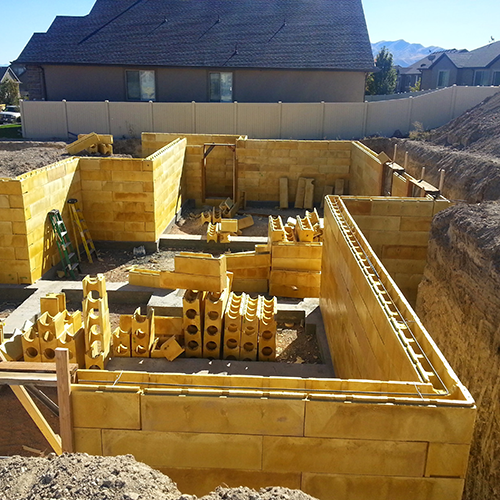Polyurethane ICF vs EPS (Styrofoam) ICFs
The billion dollar ICF blocks market is already gigantic & estimated to double or triple in the next 5-7 years
.
ICF construction is already very popular for homes and buildings & has found new niche markets in pool construction, giant freezers, & other specialty applications
.
There’s basically EPS(Styrofoam) vs Polyurethane foam
.
EPS(Styrofoam) is most common because of current prices and availability.
EPS(Styrofoam) is less insulating than Polyurethane per inch of thickness
A typical EPS(Styrofoam) block has 2.5 inches of foam on each side of the block to make R22 worth of insulation value, that’s similar to what can be acheived with wood framing
To be more compelling in the market the EPS(Styrofoam) blocks have more expenive models that have fatter walls to be R30 insulation, yet now they are too fat… Each wall is up to 4-5 inches of foam on each side of the concrete! Our blocks are thinner, more insulating & less expensive than theirs
.
Polyurethane foam has nearly double the insulation value & we are one of the only companies able to manufacture polyurethane ICFs & the only one to be able to get it down to such extraordinarily low prices
Our comparable Powerblock has thinner 2 inch R30 walls & is less expensive than their R22 2.5 inch thick wall blocks
Our goal is to compete then make EPS(Styrofoam) ICFs obsolete!
Here’s a list of what A.I. says about polyurethane foam being better than EPS (Styrofoam) ICF:
-
**Higher R-Value**: Polyurethane foam has a higher R-value per inch compared to EPS, providing better insulation efficiency
-
.**Greater Strength**: Polyurethane foam is denser and stronger than EPS, offering enhanced structural integrity and impact resistance.
-
**Thinner Walls**: Polyurethane foam allows for thinner walls while maintaining the same insulation value, maximizing interior space.
-
**Better Thermal Performance**: Polyurethane foam provides superior thermal performance, reducing heating and cooling costs more effectively.
-
**Improved Sound Insulation**: Polyurethane foam offers better soundproofing properties compared to EPS, creating quieter indoor environments.
-
**Higher Fire Resistance**: Polyurethane foam has better fire resistance properties than EPS, contributing to enhanced safety.
-
**Moisture Resistance**: Closed-cell polyurethane foam is more resistant to moisture infiltration compared to EPS, reducing the risk of mold and mildew.
-
**Improved Energy Efficiency**: Polyurethane foam ICF helps buildings achieve higher energy efficiency ratings due to its superior insulation capabilities.
-
**Faster Construction**: Polyurethane foam ICFs are easier to cut and shape on-site, speeding up construction time compared to EPS.
-
**Reduced Thermal Bridging**: Polyurethane foam minimizes thermal bridging more effectively than EPS, further improving energy performance.
-
**Longer Lifespan**: Polyurethane foam is more durable and less susceptible to degradation over time compared to EPS.
-
**Better Compressive Strength**: Polyurethane foam exhibits higher compressive strength, making it suitable for a wider range of building applications.
-
**Environmental Impact**: Polyurethane foam ICFs typically have a lower environmental impact in terms of embodied energy and greenhouse gas emissions.
-
**Design Flexibility**: Polyurethane foam allows for greater design flexibility, accommodating various architectural styles and custom shapes.
-
**Improved Resilience**: Polyurethane foam ICFs are more resilient to extreme weather conditions and seismic events compared to EPS.
-
**Healthier Indoor Environment**: Polyurethane foam ICFs contribute to a healthier indoor environment by reducing allergens and improving air quality.
-
**Ease of Installation**: Polyurethane foam ICFs are lightweight and easier to handle during installation compared to EPS.
-
**Better Insulation Over Time**: Polyurethane foam maintains its insulation properties over time better than EPS, ensuring long-term energy savings.
-
**Reduced Waste**: Polyurethane foam ICFs generate less waste during installation and have a higher recycling potential compared to EPS.
-
**Higher Property Value**: Buildings constructed with polyurethane foam ICFs may have higher resale values due to their superior performance and energy efficiency.
